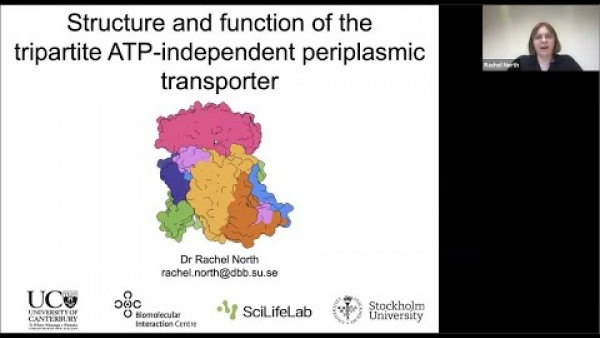BSB Seminar: The structure of a tripartite ATP-independent periplasmic (TRAP) transporter provides the molecular basis for function
Abstract
Bacterial infections remain a global public health challenge and there is a critical need for the identification and molecular understanding of new targets for antimicrobial design. Tripartite ATP-independent periplasmic (TRAP) transporters are a major class of secondary transporters that have been implicated in bacterial virulence and pathogenesis. TRAP transporters are widespread in bacteria and archaea, but are not found in eukaryotes, opening avenues for antimicrobials that are likely non-toxic to humans. Unlike other secondary transporters, TRAP transporters cannot receive their substrates directly and rely on a secreted substrate-binding protein, in a manner analogous to ATP Binding Casette (ABC) importers. What is known is that substrate is first captured by the substrate-binding protein, which then forms an association with the sodium-driven membrane transporter to hand it over for import. But mechanistically, the system is not well understood. We report the single-particle cryo-electron microscopy structure of the sialic acid TRAP transporter SiaQM from Photobacterium profundum at 2.97 Å resolution, defining them as elevator-type transporters. TRAP transporters are comprised of a “transport” domain housing a substrate binding site with at least two sodium sites and an extended “scaffold” domain. This scaffold likely enables TRAP transporters to operate as monomers rather than the typically observed oligomers for elevator-type transporters. Our crystal structure of the cognate sialic acid bound substrate-binding protein, together with co-evolution driven docking studies, provides a molecular basis for how sialic acid is delivered to the transporter for import. We conclude that TRAP transporters represent a unique family of secondary transporters that share mechanistic similarities with ABC importers, which we describe as an “elevator-with-an-operator”.
Biography
Rachel North’s research focuses on the fundamental understanding of how membrane transporters work at the molecular level. She is currently a Research Fellow in Professor David Drew’s group at Stockholm University, Sweden, where she investigates the structure and function of mammalian membrane transporters. Originally from Christchurch, New Zealand, she completed her undergraduate studies in Biology at the University of Canterbury. Rachel graduated with a PhD in Biochemistry in 2017 and completed her first postdoctoral position in Professor Ren Dobson’s group, also at the University of Canterbury. Here, she led a project exploring bacterial membrane transporters. Rachel is a keen membrane protein biologist, structural biologist and biochemist.






